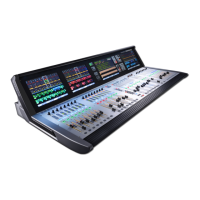4.3: INPUT CHANNEL > DYNAMICS
Vi3000 USER MANUAL
4.3 INPUT CHANNEL > De Esser5.5 5.5 Operations Overview > Buttons
Vi3000 USER MANUAL
5.5 Operations Overview > Buttons
Lower [FLW]
Button Field / Group: Inactive Active
Input faders follow mas-
ter bus selection.
The fader FOLLOW OUTPUT SOLO [FLW] button
located near the bottom of the Master Bay buttons strip
causes the input faders to become contributions to an
output bus when its [SOLO/SEL] button is pressed (often
known as ‘Sends on Faders mode’).
If a Matrix Output Solo/Sel is pressed, regardless of the
setting of Follow Solo modes, the Output Solo will be
activated, the EQ/Dyn/Misc touch screen for the Matrix
Output displayed, and the channel faders will be as-
signed to the contribution levels from the Outputs to the
Soloed Matrix Output.
Note: the lower [FLW] key has an additional function
in allowing VCAs to control the Aux sends of input
channels. See the Mute & VCA reference chapter 9 for
details.
Follow Mode Normal
Main Menu
Button Field / Group: Inactive Active
Brings up the Main
Menu screen in the
Master Bay.
Settings and preferences for a variety console functions
are arranged in tabbed pages in the main menu. For
more information, see the Main Menu reference chapter
16.
Normal
Main Menu
Active
Input Priority Field / Group: Inactive Active
Allow an Output Solo to
remain active, whilst an
Input Solo is temporarily
activated ‘over the top’
of it.
For more information see the SOLO System reference
chapter 8.
Normal
Main Menu
Active
Lock Meters Field / Group: Inactive Active
Locks the Meter section
of the Master Bay touch
screen onto the screen.
The meter section will be safe from output selections
bringing the channel up on the touchscreen, for example.
[SETUP] buttons still takeover the screen though.
Normal
Meters
Locked

